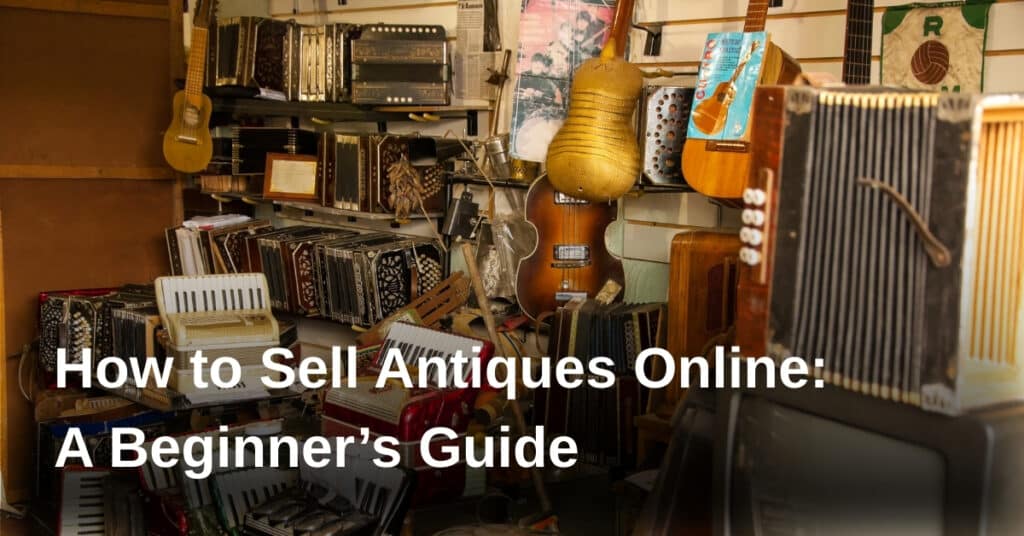
Diving into the world of antiques opens up fascinating opportunities to discover and share timeless treasures with new caretakers. However, if you’re just starting to sell antiques online, it may seem like a daunting task. From identifying genuine pieces to setting profitable prices, each step demands careful attention. Nevertheless, the online marketplace is ripe with potential, and with the right strategies, anyone can establish a flourishing niche. Whether it’s your passion for vintage clocks or an inherited collection of heirloom jewelry, these valuable items could find new homes across the globe. This guide will walk you through the essentials, ensuring your antiques stand out in the bustling online arena. Let’s embark on this rewarding journey together.
Main Points
- Research and Valuation: Understand the history and worth of your antiques to set competitive prices. Accurate valuation helps in gaining trust and maintaining transparency with potential buyers.
- Effective Listings: Craft compelling descriptions and high-quality images to highlight the unique features of your items. An engaging listing captivates the audience and increases the likelihood of a sale.
- Platform Selection: Explore various e-commerce platforms and their specific features to find the best fit for your antiques. Some platforms may cater specifically to niche markets, offering tools to enhance your selling experience.
- Customer Engagement: Build rapport with potential buyers by responding promptly and courteously to inquiries. Engaged communication fosters trust and can lead to successful transactions and repeat business.
- Shipping and Handling: Ensure safe and efficient delivery by understanding packaging techniques and choosing reliable shipping services. Proper handling is crucial to preserving the integrity of fragile antiques during transit.Understanding the Value and History of Your Antiques
The allure of antiques lies in their rich history and the stories they carry. Selling antiques is as much about understanding their origins as it is about finding the right buyer. Therefore, comprehending an item’s past enhances its value and appeal, especially if you’re looking to sell antique furniture. Tracing back a piece’s lineage can sometimes yield unexpected surprises, revealing links to notable historical events or figures.
Unveiling the Past
Examining the materials and craftsmanship offers clues to an antique’s era. For example, hand-carved details may suggest an older origin compared to machine-made items. Additionally, provenance plays a crucial role. Documents or stories that accompany an item, often ambiguous yet revealing, can significantly increase its worth.
- Documentation: Verifies the origin and age.
- Condition: Affects both aesthetic and monetary value.
- Rarity: An uncommon piece can command a higher price.
In conclusion, identifying these factors can help when hoping to sell antiques effectively.
Choosing the Right Online Platforms for Selling Antiques
Deciding where to sell antiques online can be both exhilarating and daunting. With numerous platforms available, determining the right marketplace is crucial for success. Among the many options, eBay is renowned for its extensive reach, yet it can be challenging due to high competition. Etsy, in contrast, focuses on vintage and handcrafted items, making it a favourable choice for those looking to sell unique antiques. However, it’s essential to consider each platform’s fees, audience, and ease of use.
For sellers specializing in high-value or rare items, platforms like Ruby Lane might offer the necessary exposure to a niche market, albeit with more stringent listing regulations. Alternatively, niche platforms such as Chairish cater to a sophisticated audience interested in curated antique selections, although they may have a more selective approval process. Therefore, assessing your inventory and the nature of the items you’re offering allows for a strategic choice of platform, ultimately influencing your selling antiques experience.
Crafting Compelling Descriptions to Attract Buyers
Creating engaging descriptions is essential when looking to sell antiques. The art lies in striking a balance between detail and allure, allowing potential buyers to envision the item’s history and beauty. To begin with, a vivid portrayal of the item’s appearance can be remarkably effective. Instead of merely stating its material, delve into its texture, color, and condition. Such nuances help transform a simple chair into a visual symphony of craftsmanship and era-specific charm. Furthermore, sharing any intriguing anecdotes or historical tidbits attached to the antique can spark curiosity. This could be a tiny whisper from its past or an unfamiliar tale waiting to be retold. Additionally, while authenticity details are vital, infusing a sense of mystery may also amplify interest. Finally, by communicating its intrinsic value and positioning it as a treasure within a wider cultural context, sellers can not only attract buyers but also inspire genuine appreciation. This thoughtful approach facilitates the path to successfully sell antiques while enhancing the appreciation of history intertwined with personal taste.
High-Quality Photography: Capturing the Essence of Your Antiques
To truly capture the unique charm of your antiques, mastering high-quality photography is essential. The art of photography does not only preserve the item’s condition but also tells its story in visual form. However, the trick lies in highlighting subtle qualities. Utilize natural light, especially during the soft hours of the day, to emphasize texture and subtle hues of your piece. This will prevent distortions that artificial lighting might cause.
Compose carefully, choosing a background that complements but does not overpower your antiques. The right angle—be it from above, eye-level, or close-up—can reveal intricate details that might otherwise hide. In my opinion, expert use of focus is pivotal: sharper focus can showcase specific areas, yet a softer setting provides a wholesome view.
Consider these elements when planning to photograph and eventually sell antiques. Your potential buyers will appreciate the meticulous effort, encouraging them to value not just the item but its captured essence. Understanding these nuances may seem daunting, yet the results can indeed be profoundly rewarding.
Setting Competitive Prices While Maximizing Profit
Establishing the right pricing strategy is crucial for any business aiming to balance competition with profitability. It requires a nuanced understanding of the market, including supply and demand dynamics. To achieve this, businesses should first conduct thorough market research to understand their competitors’ pricing tactics. However, it’s important not to simply mimic others. Instead, focus on the unique value your product or service provides. Consider factors like production costs, brand positioning, and perceived customer value. Striking this delicate balance can often feel like threading a needle. Still, by analyzing both internal and external factors, businesses can find that sweet spot where pricing attracts customers but doesn’t undermine profitability.
While tactics may vary, the ultimate goal remains consistent: secure business growth. Therefore, detailed pricing models and regular adjustments, based on market changes, are indispensable. Entrepreneurs should also remember that pricing isn’t static; it evolves as you establish your market presence. In the niche market of Sell antiques, historical value and rarity play a pivotal role in determining price adjustments.
Implementing Effective SEO Strategies for Greater Visibility
In today’s digital landscape, implementing effective SEO strategies is vital for enhancing online visibility. One pivotal aspect is keyword optimisation. Crafting content that incorporates relevant keywords naturally can significantly improve your search engine rankings. However, it’s essential to strike a balance, avoiding excessive use — otherwise, penalties may ensue. Moreover, understanding user intent is imperative; what are users genuinely searching for? Addressing this helps tailor content that resonates with the target audience.
Another crucial element is your website’s technical health. Factors like site speed, mobile compatibility, and secure connections play a significant role in search rankings. “A website with sluggish load times or poor mobile experience risks losing potential visitors,” according to experts. Additionally, high-quality backlinks can elevate a website’s authority, although acquiring these can be a challenging feat.
Nevertheless, by prioritising these strategies, businesses can effectively navigate the online domain, slowly capturing greater visibility. Embrace analytics, continuously refining approaches, because SEO is as much an art as it is a science.
“Effective strategies in today’s landscape demand ensuring not just visibility, but meaningful engagement with the target audience.”
Securing Safe and Reliable Shipping Methods
Choosing the right shipping method can feel daunting, especially when it involves precious items like antiques. However, ensuring that your chosen provider offers reliable services is paramount. It’s recommended to opt for companies with good track records in handling delicate goods. The importance of using proper packaging materials cannot be overstated, including bubble wrap and sturdy boxes. This, however, is only part of the equation.
Likewise, tracking capabilities are essential. The peace of mind that comes with knowing the exact location of your package at any time cannot be matched, yet not all providers offer this feature. Therefore, it becomes crucial to inquire about this beforehand.
Key Considerations for Shipping Antiques
- Provider’s reputation: Evident track record in safe shipping.
- Insurance: Offers financial protection for antique sell losses or damages.
- Tracking: Allows real-time tracking of sell antiques.
With these considerations in mind, you can embrace the process with confidence and assurance.
Building Trust with Buyers Through Authenticity and Transparency
In today’s market, fortified by digital platforms, establishing trust with potential buyers necessitates a commitment to both authenticity and transparency. For those who sell antiques, the challenge lies in communicating the genuine story behind each piece. Every item’s history amplifies its value, yet sometimes traces of uncertainty linger which can be intriguing or possibly daunting for collectors. Sharing verified provenance and detailed descriptions, albeit complex at times, assures buyers of their potential acquisitions’ genuineness.
Moreover, creating an environment of openness about pricing strategies and potential restoration can further augment trust. Although it may seem delicate, addressing uncertainties and engaging in open conversation invites buyers to feel valued and respected. Hence, this fosters a deeper connection, prompt authenticity to become a key differentiator in the crowded market. Committed sellers who do this can cultivate loyal customer relationships, an advantage that often translates into long-term success.
Managing Customer Relationships for Long-Term Success
Fostering robust customer relationships is crucial for a business aiming for long-term success. This journey is not always straightforward, as it involves various elements that might evolve over time. A company’s ability to adapt and remain relevant is critical. Engaging customers through personalized experiences creates loyalty, yet striking that right balance can be delicate. A feedback loop where clients feel genuinely heard and appreciated can make a substantial difference. Moreover, leveraging data-backed insights helps businesses anticipate needs and craft strategies accordingly. While the goal is to sell antiques or other products, understanding customer lifetime value is indispensable. Tools such as CRM systems play a pivotal role, but technology should enhance human connections, not replace them. Additionally, employees who are well-trained in communication can significantly impact customer perceptions. Thus, nurturing these relationships requires a blend of technology, empathy, and strategic foresight to cultivate a sustainable competitive edge.
Conclusion
Selling antiques online can be a rewarding journey if approached with knowledge and enthusiasm. By understanding your items’ history, setting up an attractive online presence, and engaging with potential buyers, you create a meaningful connection that resonates with collectors. Pay attention to accurate descriptions and captivating photographs, as these elements build trust and allure. Although challenges may arise, staying adaptable and learning from each transaction strengthen your selling prowess. Ultimately, combining passion with persistence helps you not only sell antiques but also share their unique stories with the world.
Related Articles:
How to Sell Audiobooks Online: A Beginner’s Guide
